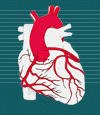 |
 |
 |
 |
 |
Radiofrequency Ablation |
|
|
|
Other methods of catheter ablation have been attempted experimentally and clinically, but radiofrequency catheter ablation is considered the safest and most effective approach. It is now the therapy of choice for a variety of arrhythmias. During radiofrequency ablation, special thin, long, flexible insulated wires (electrode catheters), are inserted in the veins in your groin and/or arm. Sometimes the physician will insert the wire in a vein on the side of your neck or in a vein in the area just below your collarbone. The catheters' movements are monitored by x-ray pictures on a video screen. These catheters are used to locate the site of the abnormal rhythm. Then the doctor will place a special catheter at that site. Radiofrequency energy is delivered through this special catheter. This causes the heat to be concentrated at the tip of the catheter. The heat creates scar tissue on the pathway of cells so that the abnormal conduction cannot pass through. The abnormal pathway is now destroyed.
Why
did my doctor order Radiofrequency Ablation for me?
Your doctor has recommended this type of treatment after examining you and reviewing the results of the diagnostic tests you took. One of these tests might have been an Electrophysiology Study (EPS). This diagnostic procedure provided a considerable amount of information about your heart rhythm. It gave your doctors an electrical "map" of your heart. The Electrophysiology Study significantly resembles the Radiofrequency Ablation except there is no treatment given during the EPS. Sometimes during the EPS, it becomes clear to the doctors that radiofrequency ablation is the treatment of choice. For this reason, it is practical for your doctor to ask for your consent to the ablation treatment at the time you give consent for the EPS. Then, if necessary, the treatment procedure can be performed right away, without requiring you to schedule another visit to the hospital. Is Radiofrequency Ablation
safe? Rare complications include damage to the heart and blood vessels, formation of blood clots, stroke, heart attack and infection. Deaths are very rare. What happens before the Radiofrequency
Ablation procedure? Tell the doctor if you are pregnant or if you have allergies, especially if you have allergies to any medications. Usually, you will have blood tests, an electrocardiogram, and a chest x-ray taken prior to the procedure. Discuss your medications with your doctor well in advance of the ablation. You may be asked to stop certain medications such as aspirin or Coumadin for a few days before the procedure. Do not eat or drink after midnight on the night prior to your procedure. You may take the approved medications with small sips of water. You should leave all valuables and money at home or with a relative. Do not wear any jewelry to the hospital. You may wear eyeglasses, dentures or dental bridges. Empty your bladder prior to the test. You may receive a mild sedative to help you relax. You will stay awake throughout the procedure. Bring someone with you who can drive you home. What happens during the Radiofrequency Ablation procedure? Electrodes will be applied to your chest and back to monitor your heart rhythm at all times. A blood pressure cuff will be placed on your arm to monitor your blood pressure. You will be shaved and cleansed with antiseptic solution in the areas where the catheter will be inserted. These steps are taken to prevent infection.. You will be covered with sterile sheets. A local anesthetic will be injected into the skin to numb the insertion areas. Then a small incision will be made in the skin. The doctors will use a special needle to puncture the blood vessel (vein or artery), into which the catheter. will be introduced. You will feel some pressure but no pain, If you do feel pain, please let the doctor know, so more numbing medication can be given to you. The catheters are then guided into your heart. You will not feel the catheters inside your body. During the actual ablation (application of heat), you may feel some minimal chest pain. . You are allowed to talk to the staff during the procedure. Let the doctor know how you feel. When the procedure is completed, the doctor will remove the catheters and apply firm pressure on the insertion site for 10-20 minutes to stop the bleeding. A light dressing is then applied to the catheter site. How long does the procedure take? After the procedure, you will be taken to a bed where you will rest with your head slightly elevated for 4-5 hours. You must lie flat in the bed and keep your legs straight. You may roll onto your side, but don't bend your knees. You can wiggle your feet and toes to avoid stiffness. After a while you will be able to eat and drink. How long will I stay in the hospital? What should I do when I get home? It is common to see a bruise or a small lump at the insertion site.. This is temporary. Call your doctor if you have a fever or if the insertion site is painful or warm. Call her if you have palpitations, dizziness, chest pain or shortness of breath. You can usually stop taking your heart rhythm medications after a successful ablation. You will probably be able to resume your normal activities within a day or two at home.
|

Copyrights © Krishna Cardiac Care Centre. All Rights Reserved. Designed by Fastcursor